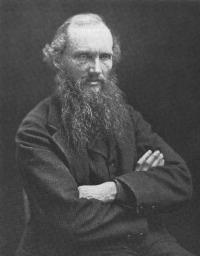 William Thomson was the son of a textbook writer who taught mathematics in Belfast, Ireland. The family moved to Glasgow, where Williams' father James had been appointed professor at the university.
William Thomson was the son of a textbook writer who taught mathematics in Belfast, Ireland. The family moved to Glasgow, where Williams' father James had been appointed professor at the university.Engineer, mathematician and physicist, b. 26 June 1824 (Belfast, Ireland), d. 17 December 1907 (Netherall near Largs, Scotland).
 William Thomson was the son of a textbook writer who taught mathematics in Belfast, Ireland. The family moved to Glasgow, where Williams' father James had been appointed professor at the university.
William Thomson was the son of a textbook writer who taught mathematics in Belfast, Ireland. The family moved to Glasgow, where Williams' father James had been appointed professor at the university.
In 1834, at the age of 10, William and his brother James, aged 11, enrolled at the University of Glasgow to study mathematics. William published his first papers before he turned 18; with 15 he had already received a gold medal for "An Essay on the Figure of the Earth."
In 1841 Thomson entered Cambridge University. He showed extraordinary mathematical ability and obtained his Batchelor of Arts with Honours in 1845.
In 1846, at the age of 22, Thomson was appointed professor of natural philosophy (a title later changed to professor of physics) at the University of Glasgow. He remained in that position until 1899, when he retired at the age of 75. The Royal Society made him a Fellow in 1851, and from 1890 to 1895 he served as its president. He was knighted in 1866 and became Lord Kelvin of Largs in 1892.
Although Thomson was trained as a mathematician his main interest was nature, particularly physics. He believed that many if not all physical phenomena are related and could thus be described through the same mathematical methods. By bringing together areas as apparently disparate as electricity, magnetism, thermodynamics, hydrodynamics, mechanics and heat he became the synthesizer of sciences at the end of the 19th century and prepared the ground for the great scientific advances of the 20th century.
Among his many contributions to modern science are the second law of thermodynamics, the absolute temperature scale, the dynamical theory of heat, the mathematical analysis of electricity and magnetism and the fundamentals of hydrodynamics. Thomson tried to estimate the age of the Earth, introducing the concept that biological and geological theory has to be based on the laws of physics.
In 1854 Thomson was consulted by the Atlantic Telegraph Company, which was planning the first transatlantic telegraph cable, about the delay of electrical signals in long cables. He became increasingly involved in the venture and participated as chief consultant in the cable-laying expeditions. In 1858 he patented a telegraph receiver, which became the standard instrument for the worldwide cable network. He became a partner in engineering consultant firms, took out patents for a marine compass, a tide calculator and a depth sounding device and established his own company to manufacture these. He died a wealthy man.
Sharlin, H. I. (1995) Kelvin, Willian Thomson, Encyclopaedia Britannica 15th ed.